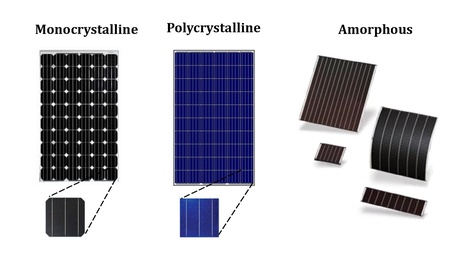Introduction[edit | edit source]
Photovoltaic energy, a form of renewable energy, originates from sunlight by employing photovoltaic (PV) cells or solar panels. These cells are crafted from semiconductor substances, primarily silicon, and they generate electricity upon exposure to sunlight. There exist four generations of photovoltaic cells:
- The first generation revolves around bluk silicon, encompassing two technologies: monocrystalline silicon and polycrystalline silicon.[1]
- The second generation is grounded in thin-film technology, primarily utilizing amorphous silicon.[2]
- The third generation entails organic photovoltaic cells and dye-sensitized solar cells (DSSCs).[3]
- The fourth generation encompasses diverse technologies like organic plasmonic photovoltaics and quantum dot (QD) solar cells.[4]
At present, the solar energy sector is primarily led by technologies relying on crystalline silicon (including both multicrystalline and monocrystalline). This dominance is owed to the abundant presence of silicon on Earth, constituting approximately 28% of the Earth's crust.[5] However, emerging "thin-film" technologies, notably CIS and CdTe, are steadily gaining prominence in the market. The upper efficiency threshold for a crystalline silicon solar cell is approximately 33.16%, as per the Shokley-Queisser limit,[6] owing to the partial absorption of incident light by the cell. Polycrystalline PV cells exhibit an average efficiency range of 13% to 20%, whereas monocrystalline cells demonstrate efficiencies between 15% and 24%. However, the manufacturing process for monocrystalline cells is intricate and costly compared to that of polycrystalline cells. On the other hand, amorphous cells demonstrate lower performance levels, with efficiencies of 6% to 12%. Nonetheless, they function reasonably well even in conditions of limited or scattered illumination, such as overcast weather or artificial lighting.

PV systems[edit | edit source]
A photovoltaic system is composed of diverse components, including:
- PV module
- Inverter
- Charge controllers
- Storage (batteries)

The production of a PV system relies on several factors, with primary considerations encompassing meteorological elements (like sunlight and temperature). Additionally, other critical parameters come into play, such as the orientation of the PV modules. Ideally, these modules should be positioned perpendicular to the sun's rays. However, in most cases, correct orientation is crucial based on the installation site's location (latitude). The performance of a photovoltaic (PV) system is influenced not only by the efficiency of the PV panels but also by other elements like inverters, charge controllers, and batteries. Another challenge lies in optimizing power output by tracking the maximum power point. The figure below presents the current-voltage (I-V) and power-voltage (P-V) characteristics.

In recent years, there has been a notable surge in scientific investigations related to photovoltaics (PV). Within this realm of scientific research, topics such as maximum power point tracking[7] and electrical modeling[8] have gained prominence. The primary objective of these endeavors is to offer solutions that maximize the utilization of the power output achievable from PV modules. It's worth noting that much of this research isn't conducted directly on PV modules themselves, but rather employs electrical models that simulate their operational behavior. Numerous electrical models can be found in the literature, including the single diode model (SDM), the double diode model (DDM), and the triple diode model (TDM).
- ↑ Green MA. Crystalline Silicon Photovoltaic Cells. Advanced Materials 2001;13:1019–22.
- ↑ Carlson D. Recent developments in amorphous silicon solar cells. Solar Energy Materials 1980;3:503–18.
- ↑ Chang DW, Choi HJ, Filer A, and Baek JB. Graphene in photovoltaic applications: organic photovoltaic cells (OPVs) and dye-sensitized solar cells (DSSCs). J. Mater. Chem. A 31 2014;2:12136–49.
- ↑ Ahmad Z, Najeeb MA, Shakoor R, Al-Muhtaseb SA, and Touati F. Lim- its and possible solutions in quantum dot organic solar cells. Renewable and Sustainable Energy Reviews 2018;82:1551–64.
- ↑ Ameur A, Berrada A, Loudiyi K, and Adomatis R. Chapter 6 - Performance and energetic modeling of hybrid PV systems coupled with battery energy storage. In: Hybrid Energy System Models. Ed. by Berrada A and El Mrabet R. Academic Press, 2021:195–238.[1]
- ↑ R ̈uhle S. Tabulated values of the Shockley–Queisser limit for single junction solar cells. Solar Energy 2016;130:139–47.
- ↑ Eltawil MA and Zhao Z. MPPT techniques for photovoltaic applications. Renewable and Sustainable Energy Reviews 2013;25:793–813.
- ↑ Elhammoudy A, Elyaqouti M, Arjdal EH, et al. Dandelion Optimizer algorithm-based method for accurate photovoltaic model parameter identification. Energy Conversion and Management: X 2023;19:100405.